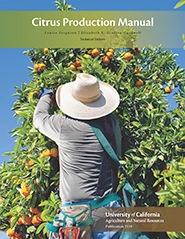It's not easy to update the IPM Handbook in paperback, but You can check out the latest IPM Pest Management Guidelines for arthropod pests at:
http://ipm.ucanr.edu/PMG/selectnewpest.citrus.html
The other sections will be updated soon. Tune in, and in the meantime if you don't have a copy of the IPM Manual, it's time to get one:
How to order
Obtain Integrated Pest Management for Citrus from the UC ANR catalog, or by mail, by telephone, and at many of the UC County Cooperative Extension offices. For more information, see "How to Order Publications."
Third Edition
Integrated Pest Management for Citrus
Published 2012 · Publication 3303 · 275 pages
| How to order List of contents |
Book excerpts: General predators in citrus Fruit disorders in citrus |
High-quality Photographs
More than 500 high-quality color photographs and dozens of drawings and charts will help you identify and manage over 150 different citrus pests and to recognize the important natural enemies of pest insects and mites. The book content includes pest insects, mites, diseases, weeds, nematodes, and vertebrates. Abiotic disorders and crop production and harvest-related problems are also covered.

